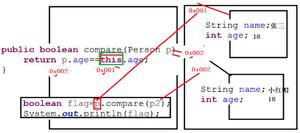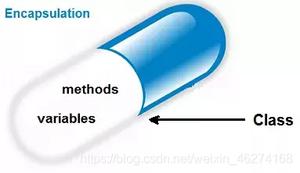201871010109-胡欢欢《面向对象程序设计(java)》第十一周学习总结

项目 | 内容 |
这个作业属于哪个课程 | https://www.cnblogs.com/nwnu-daizh/ |
这个作业的要求在哪里 | https://www.cnblogs.com/nwnu-daizh/p/11815810.html |
作业学习目标 |
|
第一部分:第八章理论知识总结(25分)
一.为什么要使用泛型程序设计
1.使用泛型机制编写的程序代码要比那些杂乱的使用object变量,然后再进行强制类型转换的代码具有更好的安全性和可读性
2.泛型程序设计意味着编写的代码可以被很多不同类型的对象所重用。
在Java中增加泛型类之前,泛型程序设计是用继承实现的。但是有两个问题:当获取一个值时必须进行强制类型转换,,这里没有错误检查,可以向数组列表中添加任何类的对象
3.类型参数的魅力在于:使得程序具有更好的可读性和安全性
二.什么是泛型程序设计
- JDK5.0中增加的泛型类型,是java语言中类型安全的一次重要改进。
- 泛型:也称参数化类型,就是在定义类,接口和方法时,通过类型参数指示将要处理的对象类型。
- 泛型程序设计:编写代码可以被很多不同类型的对象所重用
三.定义简单泛型类
。 类型变量使用大写形式,且比较短,这是很常见的。在Java库中,使用变量E来表示集合的元素类型,K和V来表示关键字与值的类型。T表示“任意类型”
。泛型:具有类型参数(类型变量),可以用其他具体的类来替代此参数,从而扩大方法的实用范围以及提高程序的安全性。
泛型类:具有一个或多个类型变量的类,用具体的类替换类型变量即为实例化泛型类。
public class Pair<T,U>
{ ... //两个以上类型变量用,隔开
}
四、泛型方法
1.除了泛型类外,还可以只单独定义一个方法作为泛型方法,用于指定方法参数或者返回值为泛型类型,留待方法调用时确定。
2.泛型方法可以声明在泛型类中,也可以声明在普通类中。
五、泛型接口的定义
●定义
public interface IPool <T>{
T get();
int add(T t);
}
●实现
public class GenericPool <T> implements IPool<T>
{
.....
}
public class GenericPool implements IPool< Account>
{
.....
}
第二部分:实验部分
实验1: 导入第8章示例程序,测试程序并进行代码注释。
测试程序1:(6分)
● 编辑、调试、运行教材311、312页代码,结合程序运行结果理解程序;
● 在泛型类定义及使用代码处添加注释;
● 掌握泛型类的定义及使用。
代码如下:
Pair类:
package pair1;/**
* @version 1.01 2012-01-26
* @author Cay Horstmann
*/
public class PairTest1
{
public static void main(String[] args)
{
String[] words = { "Mary", "had", "a", "little", "lamb" };
Pair<String> mm = ArrayAlg.minmax(words);//words是通过类名调用,依赖于ArrayAlg类
System.out.println("min = " + mm.getFirst());
System.out.println("max = " + mm.getSecond());
}
}
class ArrayAlg
{
/**
* 获取字符串数组的最小值和最大值。.
* @param a an array of strings
* @return 一个具有最小值和最大值的对,如果A为空或空,则为null
*/
public static Pair<String> minmax(String[] a)//Pair<String>实例化泛型类型
{
if (a == null || a.length == 0) return null; // 空指针引用,初始化一个空数组
String min = a[0];
String max = a[0];
for (int i = 1; i < a.length; i++)
{
if (min.compareTo(a[i]) > 0) min = a[i];//
if (max.compareTo(a[i]) < 0) max = a[i];
}
return new Pair<>(min, max);//返回新的泛型类
}
}
PairTest类
package pair1;/**
* @version 1.01 2012-01-26
* @author Cay Horstmann
*/
public class PairTest1
{
public static void main(String[] args)
{
String[] words = { "Mary", "had", "a", "little", "lamb" };
Pair<String> mm = ArrayAlg.minmax(words);//words是通过类名调用,依赖于ArrayAlg类
System.out.println("min = " + mm.getFirst());
System.out.println("max = " + mm.getSecond());
}
}
class ArrayAlg
{
/**
* 获取字符串数组的最小值和最大值。.
* @param a an array of strings
* @return 一个具有最小值和最大值的对,如果A为空或空,则为null
*/
public static Pair<String> minmax(String[] a)//Pair<String>实例化泛型类型
{
if (a == null || a.length == 0) return null; // 空指针引用,初始化一个空数组
String min = a[0];
String max = a[0];
for (int i = 1; i < a.length; i++)
{
if (min.compareTo(a[i]) > 0) min = a[i];//
if (max.compareTo(a[i]) < 0) max = a[i];
}
return new Pair<>(min, max);//返回新泛型类
}
}
测试程序2:
l 编辑、调试运行教材315页 PairTest2,结合程序运行结果理解程序;
l 在泛型程序设计代码处添加相关注释;
l 了解泛型方法、泛型变量限定的定义及用途。
PairTest2.java:
package pair2;import java.time.*;
/**
* @version 1.02 2015-06-21
* @author Cay Horstmann
*/
public class PairTest2
{
public static void main(String[] args)
{
LocalDate[] birthdays =
{
LocalDate.of(1906, 12, 9), // G. Hopper
LocalDate.of(1815, 12, 10), // A. Lovelace
LocalDate.of(1903, 12, 3), // J. von Neumann
LocalDate.of(1910, 6, 22), // K. Zuse
};
Pair<LocalDate> mm = ArrayAlg.minmax(birthdays);//实例化泛型类
System.out.println("min = " + mm.getFirst());
System.out.println("max = " + mm.getSecond());
}
}
class ArrayAlg
{
/**
获取T类型对象数组的最小值和最大值。
@param T类型的对象数组
@return 一个具有最小值和最大值的对,如果A为空或空,则为null
*/
public static <T extends Comparable> Pair<T> minmax(T[] a) //泛型方法minmax
{
if (a == null || a.length == 0) return null;
T min = a[0];
T max = a[0];
for (int i = 1; i < a.length; i++)
{
if (min.compareTo(a[i]) > 0) min = a[i];
if (max.compareTo(a[i]) < 0) max = a[i];
}
return new Pair<>(min, max);//返回泛型类
}
}
运行结果:
测试程序3:
l 用调试运行教材335页 PairTest3,结合程序运行结果理解程序;
l 了解通配符类型的定义及用途。
PairTest3.java:
package pair3;/**
* @version 1.01 2012-01-26
* @author Cay Horstmann
*/
public class PairTest3
{
public static void main(String[] args)
{
var ceo = new Manager("Gus Greedy", 800000, 2003, 12, 15);
var cfo = new Manager("Sid Sneaky", 600000, 2003, 12, 15);
var buddies = new Pair<Manager>(ceo, cfo);
printBuddies(buddies);
ceo.setBonus(1000000);
cfo.setBonus(500000);
Manager[] managers = { ceo, cfo };
var result = new Pair<Employee>();
minmaxBonus(managers, result);
System.out.println("first: " + result.getFirst().getName()
+ ", second: " + result.getSecond().getName());
maxminBonus(managers, result);
System.out.println("first: " + result.getFirst().getName()
+ ", second: " + result.getSecond().getName());
}
public static void printBuddies(Pair<? extends Employee> p)//通配符类型可将子类传递给父类
{
Employee first = p.getFirst();
Employee second = p.getSecond();
System.out.println(first.getName() + " and " + second.getName() + " are buddies.");
}
public static void minmaxBonus(Manager[] a, Pair<? super Manager> result)
{
if (a.length == 0) return;
Manager min = a[0];
Manager max = a[0];
for (int i = 1; i < a.length; i++)
{
if (min.getBonus() > a[i].getBonus()) min = a[i];
if (max.getBonus() < a[i].getBonus()) max = a[i];
}
result.setFirst(min);
result.setSecond(max);
}
public static void maxminBonus(Manager[] a, Pair<? super Manager> result)
{
minmaxBonus(a, result);
PairAlg.swapHelper(result); // OK--swapHelper captures wildcard type捕获通配符类型
}
// can't write public static <T super manager> . . .无法写入公共静态
}
class PairAlg
{
public static boolean hasNulls(Pair<?> p)
{
return p.getFirst() == null || p.getSecond() == null;
}
public static void swap(Pair<?> p) { swapHelper(p); }
public static <T> void swapHelper(Pair<T> p)
{
T t = p.getFirst();
p.setFirst(p.getSecond());
p.setSecond(t);
}
}
package pair3;
/**
* @version 1.00 2004-05-10
* @author Cay Horstmann
*/
public class Pair<T> //Pair引入一个类型变量T(泛型类可以有多个类型变量)
{
private T first;//类定义中的类型变量指定方法的返回类型以及域和局部变量的类型
private T second;
public Pair() { first = null; second = null; }
public Pair(T first, T second) { this.first = first; this.second = second; }
public T getFirst() { return first; }
public T getSecond() { return second; }
public void setFirst(T newValue) { first = newValue; }
public void setSecond(T newValue) { second = newValue; }
}
package pair3;
public class Manager extends Employee
{
private double bonus;
/**
@param name the employee's name
@param salary the salary
@param year the hire year
@param month the hire month
@param day the hire day
*/
public Manager(String name, double salary, int year, int month, int day)
{
super(name, salary, year, month, day);
bonus = 0;
}
public double getSalary()
{
double baseSalary = super.getSalary();
return baseSalary + bonus;
}
public void setBonus(double b)
{
bonus = b;
}
public double getBonus()
{
return bonus;
}
}
package pair3;
import java.time.*;
public class Employee
{
private String name;
private double salary;
private LocalDate hireDay;
public Employee(String name, double salary, int year, int month, int day)
{
this.name = name;
this.salary = salary;
hireDay = LocalDate.of(year, month, day);
}
public String getName()
{
return name;
}
public double getSalary()
{
return salary;
}
public LocalDate getHireDay()
{
return hireDay;
}
public void raiseSalary(double byPercent)
{
double raise = salary * byPercent / 100;
salary += raise;
}
}
实验2:结对编程练习
实验2:结对编程练习,将程序提交到PTA(2019面向对象程序设计基础知识测试题(2))
(1)编写一个泛型接口GeneralStack,要求类中方法对任何引用类型数据都适用。GeneralStack接口中方法如下:
push(item); //如item为null,则不入栈直接返回null。
pop(); //出栈,如为栈为空,则返回null。
peek(); //获得栈顶元素,如为空,则返回null.
public boolean empty();//如为空返回true
public int size(); //返回栈中元素数量
(2)定义GeneralStack的子类ArrayListGeneralStack,要求:
ü 类内使用ArrayList对象存储堆栈数据,名为list;
ü 方法: public String toString()//代码为return list.toString();
ü 代码中不要出现类型不安全的强制转换。
(3)定义Car类,类的属性有:
private int id;
private String name;
方法:Eclipse自动生成setter/getter,toString方法。
(4)main方法要求
ü 输入选项,有quit, Integer, Double, Car 4个选项。如果输入quit,程序直接退出。否则,输入整数m与n。m代表入栈个数,n代表出栈个数。然后声明栈变量stack。
ü 输入Integer,打印Integer Test。建立可以存放Integer类型的ArrayListGeneralStack。入栈m次,出栈n次。打印栈的toString方法。最后将栈中剩余元素出栈并累加输出。
ü 输入Double ,打印Double Test。剩下的与输入Integer一样。
ü 输入Car,打印Car Test。其他操作与Integer、Double基本一样。只不过最后将栈中元素出栈,并将其name依次输出。
特别注意:如果栈为空,继续出栈,返回null
输入样例
Integer
5
2
1 2 3 4 5
Double
5
3
1.1 2.0 4.9 5.7 7.2
Car
3
2
1 Ford
2 Cherry
3 BYD
quit
输出样例
Integer Test
push:1
push:2
push:3
push:4
push:5
pop:5
pop:4
[1, 2, 3]
sum=6
interface GeneralStack
Double Test
push:1.1
push:2.0
push:4.9
push:5.7
push:7.2
pop:7.2
pop:5.7
pop:4.9
[1.1, 2.0]
sum=3.1
interface GeneralStack
Car Test
push:Car [id=1, name=Ford]
push:Car [id=2, name=Cherry]
push:Car [id=3, name=BYD]
pop:Car [id=3, name=BYD]
pop:Car [id=2, name=Cherry]
[Car [id=1, name=Ford]]
Ford
interface GeneralStack
结对编程实验代码:
package week111;public interface GeneralStack<T> {
public T push(T item);//判断栈是否为空
public T pop();//出栈,如果栈为空则返回null
public T peek();//获得栈顶元素,如果为空,则返回null
public boolean empty();//如为空返回true
public int size(); //返回栈中元素数量
}
package week111;public class Car {
private int id;
private String name;
public String toString() {
return "Car ["+"+name+']';
}
public int getId() {
return id;
}
public void setId()
{
this.id=id;
}
public String getName(){
return name;
}
public void setName(String name) {
this.name=name;
}
public Car(int id,String name)
{
this.id=id;
this.name=name;
}
}
package week111;import java.util.ArrayList;
public class ArrayListGeneralStack<E> implements GeneralStack {
ArrayList list=new ArrayList<E>();
public String toString() {
return list.toString();
}
@Override
public Object push(Object item) {
// TODO Auto-generated method stub
if(list.add(item)) {
return item;
}
else
{
return false;
}
}
@Override
public Object pop() {
// TODO Auto-generated method stub
if(list.size()==0) {
return null;
}
return list.remove(list.size()-1);
}
@Override
public Object peek() {
// TODO Auto-generated method stub
return list.get(list.size()-1);
}
@Override
public boolean empty() {
// TODO Auto-generated method stub
if(list.size()==0) {
return true;
}else {
return false;
}
}
@Override
public int size() {
// TODO Auto-generated method stub
return list.size();
}
}
package week111;import java.util.Scanner;
public class Main {
public static void main(String[] args) {
Scanner sc=new Scanner(System.in);
while(true) {
String s=sc.next();
if(s.equals("Double")) {
System.out.println("Double Test");
int count=sc.nextInt();
int pop_time=sc.nextInt();
ArrayListGeneralStack generalStack=new ArrayListGeneralStack();
for(int i=0;i<count;i++) {
System.out.println("push:"+generalStack.push(sc.nextDouble()));
}
for(int j=0;j<pop_time;j++)
{
System.out.println("pop:"+generalStack.pop());
}
System.out.println(generalStack.toString());
double sum=0;
int size=generalStack.size();
for(int i=0;i<size;i++) {
sum+=(double)generalStack.pop();
}
System.out.println("sum="+sum);
System.out.println("interface GeneralStack");
}else if(s.equals("Integer")) {
System.out.println("Integer Test");
int count=sc.nextInt();
int pop_time=sc.nextInt();
ArrayListGeneralStack generalStack=new ArrayListGeneralStack();
for(int i=0;i<count;i++)
{
System.out.println("push:"+generalStack.push(sc.nextInt()));
}
for(int j=0;j<pop_time;j++)
{
System.out.println("pop:"+generalStack.pop());
}
System.out.println(generalStack.toString());
int sum=0;
int size=generalStack.size();
for(int i=0;i<size;i++) {
sum+=(int)generalStack.pop();
}
System.out.println("sum="+sum);
System.out.println("interface GeneralStack");
}else if (s.equals("Car")){
System.out.println("Car Test");
int count=sc.nextInt();
int pop_time=sc.nextInt();
ArrayListGeneralStack generalStack = new ArrayListGeneralStack();
for (int i=0;i<count;i++){
int id=sc.nextInt();
String name=sc.next();
Car car = new Car(id,name);
System.out.println("push:"+generalStack.push(car));
}
for (int i=0;i<pop_time;i++){
System.out.println("pop:"+generalStack.pop());
}
System.out.println(generalStack.toString());
if (generalStack.size()>0){
int size=generalStack.size();
for (int i=0;i<size;i++){
Car car=(Car) generalStack.pop();
System.out.println(car.getName());
}
}
System.out.println("interface GeneralStack");
}else if (s.equals("quit")){
break;
}
}
}
}
实验总结:
1 泛型的概念定义:
i.引入了参数化类型(Parameterized Type)的概念,改造了所有的Java集合,使之都实现泛型,允许程序在创建集合时就可以指定集合元素的类型,比如List<String>就表名这是一个只能存放String类型的List;
ii. 泛型(Generic):就是指参数化类型,上面的List<String>就是参数化类型,因此就是泛型,而String就是该List<String>泛型的类型参数;
3) 泛型的好处:
i. 使集合可以记住元素类型,即取出元素的时候无需进行强制类型转化了,可以直接用原类型的引用接收;
ii. 一旦指定了性参数那么集合中元素的类型就确定了,不能添加其他类型的元素,否则会直接编译保存,这就可以避免了“不小心放入其他类型元素”的可能;
2,通配符
1.)在实例化对象的时候,不确定泛型参数的具体类型时,可以使用通配符进行对象定义。
2)<? extends Object>代表上边界限定通配符
3) <? super Object>代表下边界限定通配符。
实验心得:
通过本周的学习,我掌握了泛型类、泛型方法及泛型接口的定义及泛型变量的限定,通过上课时老师的讲解,我对知识点的理解得以加深。
在本周结对编程训练时,我发现自己对于Java程序的编写还不是很熟练,今后我会加大训练量,争取做的更好。
以上是 201871010109-胡欢欢《面向对象程序设计(java)》第十一周学习总结 的全部内容, 来源链接: utcz.com/z/394162.html








